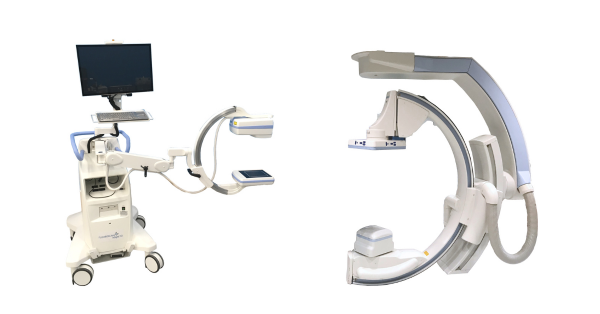
As if the initial decision to open a surgical center wasn't big enough, those of you entering this territory are about to find yourselves embarking on a series of subsequent big decisions. One of the biggest choices will be which imaging equipment you choose.
The systems you're likely to need fall into two major categories: Mobile C-arms and cath/angio or interventional labs. Because the price points, technical features, service costs, and applications for these products are very different from one another, it's important to have an understanding of what each system's intended use is.
Power and feature areas will be the most important factors in deciding between C-arms and cath labs. Both have strengths in certain procedures and certain settings and it's important to be certain that you have the right tool for the intended job.
Note: Block Imaging provides new and refurbished cath and C-arm machines and parts in order to solve all the pain points listed above. You can read about it in detail below or reach out to our sales team to learn more about how it can help improve diagnostic imaging.
Power
There's no contest in this area. In terms of sheer power, the cath lab takes the cake. Current C-arm generators have an output of 7.5kW to 25kW while cath labs will have much more power at 100kW. As a result, a C-arm can't match the output and duration a cath lab can handle.
For longer or more advanced studies that require extended fluoro time, you'll likely need the power of the cath lab. For lighter work, like pain management or basic surgery, a C-arm will do the trick.
Note: cath labs have built-in closed-loop tube cooling to keep the tube cool during long studies, where a C-arm might have a built-in fan to keep the tube cool.
Features
Overall, cath labs are more feature-rich than C-arms. Additional post-processing options, table-side controls, and multiple review stations are just a few of the things you'll find on a cath system that you won't on a C-arm.
Many of these features are intended to help facilitate the longer and/or more advanced work done in cath labs. Once again, if you're performing lighter, more basic studies, these are features that will not be essential for you.
Many cath labs also have the large monitor upgrade for better viewing of the image, which can be enlarged across the entire screen if desired.
In some cases, C-arms and cath labs overlap in the work they're used for. If the nature of the specialties you plan to pursue doesn't have you leaning in a clear direction by now, the following are factors that could also play a part in your decision.
Logistical Costs
C-arms have a big advantage in this area. These systems are mobile, can plug into a standard 120v outlet, and, depending on your local regulations, don't generally require any fixed lead shielding. Also, setting up a C-arm usually takes less than an hour.
Depending on the accommodations in your existing space, a cath lab installation could require significant remodeling. For a remodel it is wise to consult plumbers, electricians, HVAC, and general contractors. Of course, the imaging engineers who will install the equipment should also be involved. Depending on the make/model of a cath lab, install time could take 2-3 weeks.
Shielding requirements are also more stringent for cath labs. The lab room will most likely need to be lined with leaded drywall. On top of remodeling time, it takes about two weeks to install a cath lab.
When working with Block Imaging for a cath project, expect to have preliminary and specification drawings for the proposed space prepared for you. These drawings can be incorporated into the architectural and construction drawings and detail everything required to properly build the room out to accept the system. General contractor, electrician, HVAC contractor, etc., will all need to review their portions of the build out, and depending on the type of facility, a plumber may be needed to install a sink according to guidelines.
System Price
Our C-arm and cath lab price guides go into the most detail on price, but in terms of ongoing costs, Cath labs are all but guaranteed to cost more.
A cath lab is simply a larger piece of equipment with more components and moving parts. If a major part should fail in a cath lab, the replacement cost will be substantially greater.
For example, an x-ray tube for a cath lab can cost $40,000 - $60,000 while a C-arm tube averages between $6,000 and $10,000.
Cath labs also have digital detectors standard—cost for a replacement is probably $30,000-$100,000 if it goes out. We’re also starting to see more c-arms with detectors, which vary in replacement costs as well.
One often overlooked way to save some capital on room prep for a cath lab is to start early with the site prep. If you know the make and model of cath lab you want to install, make sure to work with someone like us to get site specific drawings for that system completed early in the process, that way you can build for the future and not have to deal with expensive construction changes down the line.
Final Takeaway
There are a multitude of factors to consider before choosing a C-arm or cath lab for your facility. A C-arm may be the better option if you're looking for something mobile-friendly, cost-friendly, and able to perform simpler scans.
If you are a facility just starting out and looking to manage costs, as long as the studies support the use of a c-arm, starting with a c-arm rental could be a great option. We’ve seen facilities work on planning for a cath lab but started with a c-arm and the intent to upgrade later.
A cath lab may be a better fit if you're looking to do more in-depth studies, and procedures, and have the budget to outfit an entire OR room.
Regardless of which fluoroscopy system you choose, Block Imaging is here to answer your questions and help you make the best pick for your facility's needs.
If you'd like to learn more about C-arm or cath lab equipment, contact us to talk to one of our experts or download one of our free e-guides to continue researching on your own.
Download your C-arm Buyer's Guide here:
Download your Cath Buyer's Guide here:

Kenn Dextrom
Kenn Dextrom is the Director of Product Manager at Block Imaging. He aims to provide clear direction and careful planning for Interventional Cath Lab buyers and working with the Block Imaging product team to provide excellent solutions for our customers. Out of the office, he spends most of his time keeping up with his wife and their three energetic sons.







